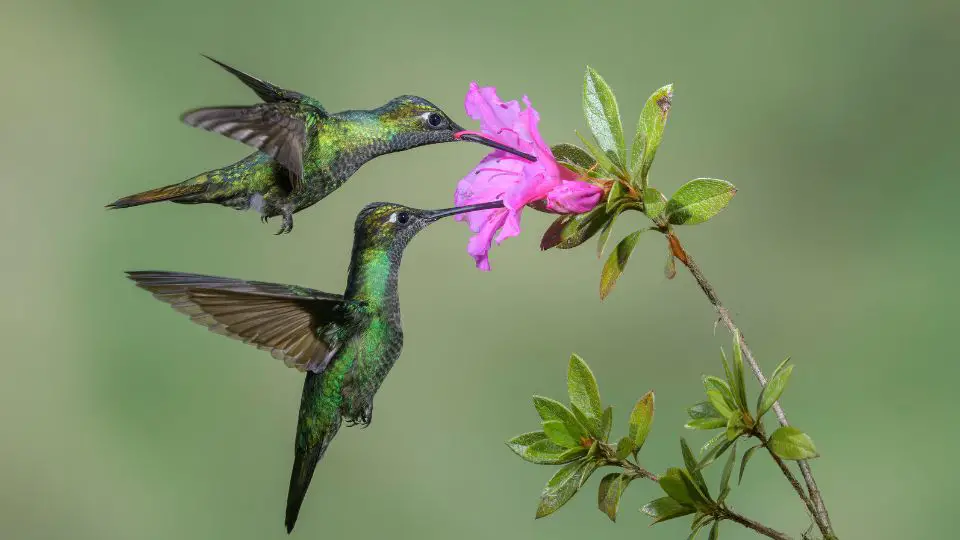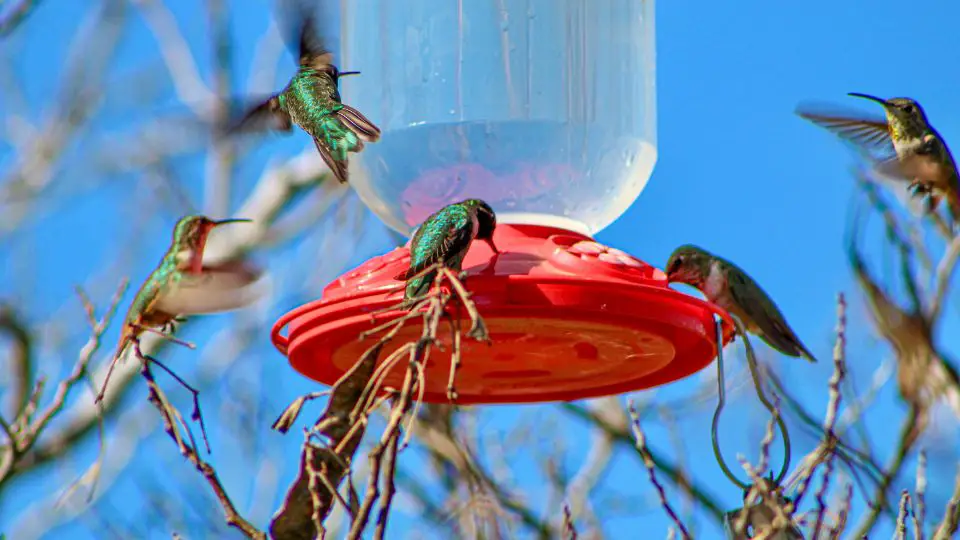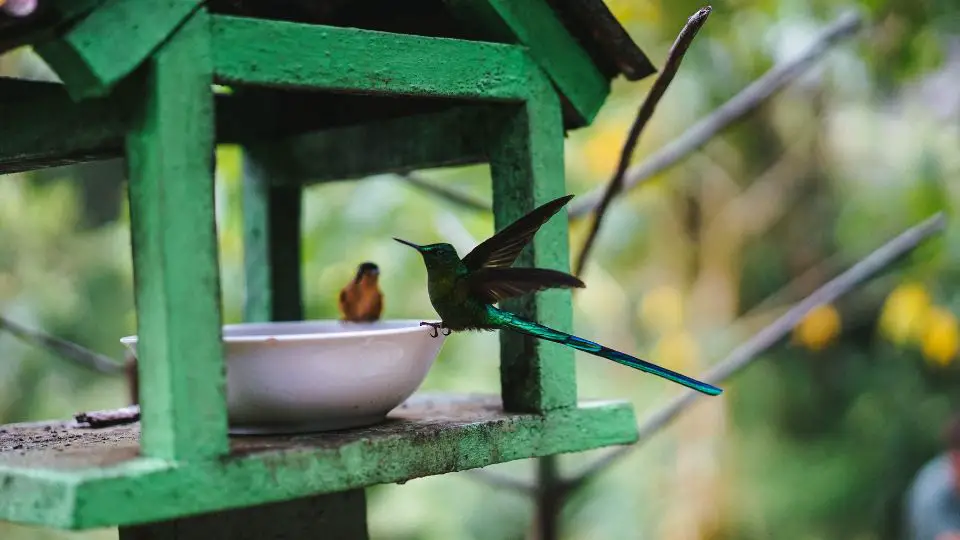Hummingbirds are magnificent tiny birds with a fast metabolism and need many different food sources to survive. Their diets include natural and artificial nectars, insects, and tree sap. Occasionally, they'll also have ashes and sand for additional salts and minerals.
To keep your visitors happy, you should offer them hummingbird nectar made from sugar and water. You can also plant some native flowers and install a bird bath. Keep reading to see what hummingbirds like to eat and how much food they need to survive.
Table of Contents
How Do Hummingbirds Use Their Beak to Eat?
Many people believe hummingbirds use their beaks as straws and suck in the nectar. However, the way they use their beaks is a bit more complex. Experienced birders know that the hummingbird’s tongue plays a crucial role in how these birds eat.
Different types of hummingbirds will look for flowers best suited for the size of their beaks. Then, they’ll use their tongue to get the nectar out of the flower. Their tongue is forked and packed with tiny hairs which collect nectar.
How Often Do Hummingbirds Eat?
Even though they have very low body weight, hummingbirds have a high metabolism. So much so that they have to eat every 15 to 20 minutes and have an intake of about equivalent to 150,000 human calories.
They eat all day long until they go to sleep. Then repeat the cycle the following day. Moreover, hummingbirds consume about half of their body weight in bugs and nectar. They also visit up to 2,000 flowers daily.
Besides the flower nectar, they also drink hummingbird nectar, eat insects, and drink tree sap to survive. All this food helps their metabolism keep up with their fast wings and increased heartbeat.
What Nutrients Do Hummingbirds Need?
Hummingbirds have a well-rounded diet that consists of more than just flower nectar and sucrose. Actually, most of their nutrients come from insects that provide amino acids and proteins.
Plus, ornithologists estimate that spiders are between 60% and 80% of their diet. They will also feed insects to their babies. Some of their favorite insects are:
- Gnats
- Aphids
- Fruit flies
- Wasps
- Other flying insects
- Larvae
However, in order to eat insects, they have to catch them, but they’re highly skilled at it. These birds will hunt insects in several ways, including gleaning, picking them up from the surface, hawking them in mid-air, and plucking them from spider webs.
These birds are also sapsuckers and occasionally drink the tree sap from the holes they find along the way. Tree sap provides a decent amount of sucrose to the birds.

What Is a Hummingbird’s Favorite Food?
Due to their increased need for food, hummingbirds will eat a variety of small insects and drink nectars from tubular flowers. They’ll remember the location of each flower and how long it takes to refill.
Still, these tiny birds love one more food source besides the flower nectar. However, it’s safe to say one of their favorite food is the hummingbird nectar you make for them.
In a way, they’ve become dependent on the hummingbird feeders filled with sugar water. It’s a food source they will easily find; plus, it’s always available, so it’s no wonder they like it.
What Is the Best Way to Feed Hummingbirds?
If you decide to hang a bird feeder, you should use the right nectar recipe to keep hummingbirds healthy, happy, and satiated. Know that you should avoid any other artificial sweeteners—table sugar is the best. Also, avoid any red dyes, as these could hurt the birds.
Use a ratio of 1 part sugar to 4 parts water to make the nectar. Use warm water to dissolve the sugar crystals and mix until they’re completely melted.
This nectar will last long enough; just store it in the fridge. Replace it about every other day, keep the feeders clean, and you’ll have an abundance of hummingbirds visit the feeder.
Additionally, you can plant native and tubular flowers in your garden. This will give hummingbirds more food sources and possibly reduce their need to fight over flowers and feeders. Their favorites include:
- Bee balm
- Salvia
- Coral honeysuckle
- Fuchsia, and other native plants
What Do Hummingbirds Eat in the Winter?
Most hummingbirds will eat for the whole summer, then stop and migrate to warmer areas for winter. However, some hummingbirds stay in the US even when it gets cold.
Once the flowers wilt and the natural nectar sources are gone, they’ll turn towards other food sources. One of these will be the
Sugar water will give them a decent amount of energy to survive the winter. Plus, they look for tree sap from holes drilled by woodpeckers.
What Do Hummingbirds Drink?
In a way, one could say that hummingbirds “drink” flower nectar and sugar water with their tongues. They need regular water sources, just like any other living being.
However, they don’t need that much water since they get most of their hydration from homemade nectar. Plus, they’ll usually drink morning dew where it’s available.
If you still want to offer a water source to hummingbirds, you can do so with a bird bath. Still, hummingbirds will likely use this water for bathing and not drinking.
Remember, this bird bath should differ from other bird baths in your yard. You’ll want a shallow bird bath with sprinklers or drippers. It should also be brightly colored to attract hummingbirds.

Other Fun Facts to Know About Hummingbird Food
Here are some other interesting facts about hummingbird diets:
- Anna’s hummingbirds eat insects like midges and leaf hoppers
- Ruby-throated hummingbirds eat mosquitos
- The Rufous hummingbird is known to follow sapsuckers
- Some hummingbirds will eat ashes and sand for minerals and salts
- During birdwatching, you might notice them sip on berries, apples, pears, and oranges (peeled)
- Never use honey or molasses instead of sugar, as these could be dangerous to hummingbirds
- Hummingbirds are territorial, so you might see them fighting over food sources
Hummingbird Diet Overview
Hummingbirds are small, yet they still need to eat every 20 minutes to survive. Their high metabolism and constant movement help them burn calories quickly.
Luckily, their diet includes many different food sources, so even wintering hummingbirds won’t get hungry. Most species of hummingbirds will feed on small insects, flower nectar, and tree sap.
They’ll maintain a healthy ecosystem in your garden with pollination and by eating insects. You can also keep them healthy and happy by offering sugar water from clean feeders.

